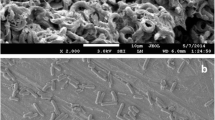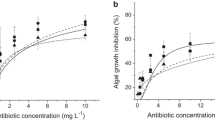Abstract
This study investigated the cytotoxicity of gemcitabine using the marine ciliate Euplotes vannus as the test organism. The median lethal concentrations (LC50 values) were determined using acute toxicity tests within an exposure time of 30 min with 0, 6, 12, 24, and 48 mg mL−1 gemcitabine. The median inhibition effect (IC50 value) on the growth of the ciliate cells was examined using chronic toxicity tests within 5 days (120 h) after exposure for 30 min with 0, 0.7, 3.5, 7, and 14 mg mL−1 gemcitabine. The 30-min LC50 value was 10.66mg mL−1. The LC50 values decreased with increasing exposure times and well fitted to the toxicity curve equation LC50 = 10.93 + 28.4e−0.19t (R2 =0.93; P < 0.05, t=exposure time). The IC50 value for growth rates was 7.05 mg mL−1, and the inhibition effect on growth rates well fitted to the model equation r%= 0.8681e−0.0782Cgem (r% means growth rate with inhibition by gemcitabine, Cgem means concentrations of gemcitabine, R2 =0.99 and P< 0.05). The LC50 values of a wide range of gemcitabine concentrations could therefore be predicted for any given exposure time. These results suggest that the clinical dose of gemcitabine (20mg mL−1) was higher than the 30-min LC50 value, which was almost the same as the 6-min LC50 value (19.88 mg mL−1) for E. vannus cells. The results also demonstrate that E. vannus can be used as a robust test organism for bioassays of chemotherapeutic drugs during short exposure periods.
Similar content being viewed by others
References
Alvarellos, M. L., Lamba, J., Sangkuhl, K., Thorn, C. F., Wang, L., Klein, D. J., Altman, R. B., and Klein, T. E., 2014. Pharm-GKB summary: Gemcitabine pathway. Pharmacogenetics and Genomics, 24: 564–574.
Bearden, A. P., Sinks, G. D., and Schultz, T. W., 1999. Acclimation to sublethal exposures to a model nonpolar narcotic: Population growth kinetics and membrane lipid alterations i. Tetrahymena pyriformis. Aquatic Toxicology, 46: 11–21.
Birhanu, G., Javar, H. A., Seyedjafari, E., and Zandi-Karimi, A., 2017. Nanotechnology for delivery of gemcitabine to treat pancreatic cancer. Biomedicine and Pharmacotherapy, 88: 635–643.
Burrows, M. T., Burns, J. E., and Suzuki, Y., 2017. Studies on the growth of cells: The cultivation of bladder and prostatic tumors outside the body. The Journal of Urology, 197: s2–s14.
Cerqueira, N. M., Fernandes, P. A., and Ramos, M. J., 2007. Understanding ribonucleotide reductase inactivation by gemcitabine. Chemistry: A European Journal, 13: 8507–8515.
Chen, Z., and Song, W., 2002. Phylogenetic postions of Aspi-disca steini and Euplotes vannus within the order Euplotida (Hypotrichia: Ciliophora) inferred from complete small sub-unit ribosomal RNA gene sequences. Acta Protozoologica, 41: 1–9.
Coppellotti, O., 1998. Sensitivity to copper in a ciliate as a possible component of biological monitoring in the Lagoon of Venice. Archives of Environmental Contamination and Toxicology, 35: 417–425.
Dayeh, V. R., Lynn, D. H., and Bols, N. C., 2005. Cytotoxicity of metals common in mining effluent to rainbow trout cell lines and to the ciliated protozoa. Tetrahymena thermophila. Toxicology in Vitro, 19: 399–410.
Dive, D., and Leclerc, H., 1975. Standardized test method using protozoa for measuring water pollutant toxicity. Progress in Water Technology, 7: 67–72.
Dubey, R. D., Saneja, A., Gupta, P. K., and Gupta, P. N., 2016. Recent advances in drug delivery strategies for improved therapeutic efficacy of gemcitabine. European Journal of Pharmaceutical Sciences, 93: 147–162.
Dyawanapelly, S., Kumar, A., and Chourasia, M. K., 2017. Lessons learned from gemcitabine: Impact of therapeutic carrier systems and gemcitabine’s drug conjugates on cancer therapy. Critical Reviews in Therapeutic Drug Carrier Systems, 34: 63–96.
Fernandez-Leborans, A., 2000. Protozoan species in three epibenthic areas of the Cantabrian Sea: Relations with environmental factors. Journal of the Marine Biological Association of the United Kingdom, 80: 407–418.
Fuma, S., Ishii, N., Takeda, H., Miyamoto, K., Yanagisawa, K., Ichimasa, Y., Saito, M., Kawabata, Z., and Polikarpov, G., 2003. Ecological effects of various toxic agents on the aquatic microcosm in comparison with acute ionizing radiation. Journal of Environmental Radioactivity, 67: 1–14.
Girling, A. E., Pascoe, D., Janssen, C. R., Peither, A., Wenzel, A., Schafer, H., Neumeier, B., Mitchell, G. C., Taylor, E. J., Maund, S. J., Lay, J. P., Juttner, I., Crossland, N. O., Stephenson, R. R., and Persoone, G., 2000. Development of methods for evaluating toxicity to freshwater ecosystems. Ecotoxicology and Environemental Safety, 45: 148–176.
Gray, J. S., and Ventilla, R. J., 1973. Growth rates of sediment living marine protozoa as a toxicity indicator for heavy metals. AMBIO, 2: 118–121.
Herllung-Larsen, P., Assaad, F., Pankratova, S. B., Saietz, L., and Skovgaard, L. T., 2000. Effects of pluronic F-68 on Tetrahy-mena cells: Protection against chemical and physical stress and prolongation of survival under toxic conditions. Biotechnology, 76: 185–195.
Hong, Y., Tan, Y., Meng, Y., Yang, H., Zhang, Y., Warren, A., Li, J., and Lin, X., 2017. Evaluation of biomarkers for ecotoxicity assessment by dose-response dynamic models: Effects of ni-trofurazone on antioxidant enzymes in the model ciliated protozoa. Euplotes vannus. Ecotoxicology and Environmental Safety, 144: 552–559.
Hong, Y., Lin, X., Cui, X., Zhou, L., Al-Rasheid, K. A. S., and Li, J., 2015. Comparative evaluatation of genotoxicity induced by nitrofurazone in two ciliated protozoa by detecting DNA strand breaks and DNA-protein crosslinks. Ecological Indicators, 54: 153–160.
Krown, S. E., 2011. Treatment strategies for Kaposi sarcoma in sub-Saharan Africa: Challenges and opportunities. Current Opinion in Oncology, 23: 463–468.
Li, J., Zhou, L., Lin, X., Yi, Z., and Al-Rasheid, K. A. S., 2014. Characterizing dose-reponse of catalase to nitrofurazone exposure in model ciliated protozoa. Euplotes vannus for ecoto-xicity assessment: Enzyme activity and mRNA expression. Ecotoxicology and Environemental Safety, 100: 294–302.
Moreno-Garrido, I., and Canavate, J. P., 2001. Assessing chemical compounds for controlling predator ciliates in outdoor mass cultures of the green alga. Dunaliella salina. Aquacultural Engineer, 24: 107–114.
Pishvaian, M. J., and Brody, J. R., 2017. Therapeutic implications of molecular subtyping for pancreatic cancer. Oncology (Williston Park, N.Y.), 31: 159–166, 168.
Rachel, A., 2009. Cancer Chemotherapy. Wiley-Blackwell, Oxford, 369pp.
Rogerson, A., 1983. Determination and interpretation of hydrocarbon toxicity to ciliate protozoa. Aquatic Toxicology, 3: 215–228.
Seward, J. R., Sinks, G. D., and Schultz, T. W., 2001. Repro-ducibility of toxicity across mode of toxic action in the Tetrahymena population growth impairment assay. Aquatic Toxicology, 53: 33–47.
Siddall, E., Khatri, M., and Radhakrishnan, J., 2017. Capillary leak syndrome: Etiologies, pathophysiology, and management. Kidney International, 92 (1): 37–46, DOI: 10.1016/j.kint.2016. 11.029.
Xu, H., Song, W., and Warren, A., 2004. An investigation of the tolerance to ammonia of the marine ciliate Euplotes vannus (Protozoa, Ciliophora). Hydrobiologia, 519: 189–195.
Zhang, W., Xu, F., Han, J., Sun, Q., and Yang, K., 2015. Comparative cytotoxicity and accumulation of Roxarsone and its photodegradates in freshwater protozoan Tetrahymena ther-mophila. Journal of Hazardous Materials, 286: 171–178.
Zhang, W., Xu, H., Jiang, J., Zhu, M., and Al-Reshaid, K. A. S., 2012. Colonization dynamics in trophic-functional structure of periphytic protest communities in coastal waters. Marine Biology, 159: 735–748.
Zhang, X. W., Ma, Y. X., Sun, Y., Cao, Y. B., Li, Q., and Xu, C. A., 2017. Gemcitabine in combination with a second cytotoxic agent in the first-line treatment of locally advanced or metastatic pancreatic cancer: A systematic review and meta-analysis. Targeted Oncology, 12 (3): 309–321, DOI: 10.1007/s11523-017-0486-5.
Zhou, L., Li, J., Lin, X., and Al-Rasheid, K. A. S., 2011. Use of RAPD to detect DNA damage induced by nitrofurazone in marine ciliate, Euplotes vannus (Protozoa, Ciliophora). Aquatic Toxicology, 103: 225–232.
Acknowledgments
This work was supported by the National Natural Science Foundation of China (Nos. 31672308 and 40206021).
Author information
Authors and Affiliations
Corresponding author
Rights and permissions
About this article
Cite this article
Wang, Q., Xu, H. & Warren, A. A Bioassay for the Cytotoxicity of Gemcitabine Using the Marine Ciliate Euplotes vannus. J. Ocean Univ. China 18, 675–679 (2019). https://doi.org/10.1007/s11802-019-4004-5
Received:
Revised:
Accepted:
Published:
Issue Date:
DOI: https://doi.org/10.1007/s11802-019-4004-5




